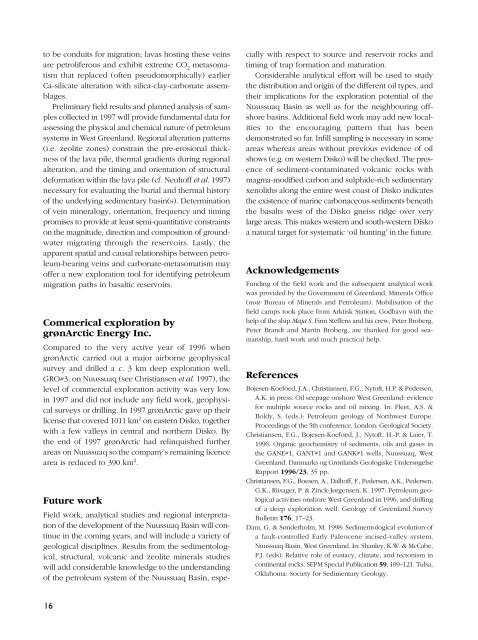Review of Greenland activities 1997 - Geus
Review of Greenland activities 1997 - Geus
Review of Greenland activities 1997 - Geus
Create successful ePaper yourself
Turn your PDF publications into a flip-book with our unique Google optimized e-Paper software.
to be conduits for migration; lavas hosting these veins<br />
are petroliferous and exhibit extreme CO 2<br />
metasomatism<br />
that replaced (<strong>of</strong>ten pseudomorphically) earlier<br />
Ca-silicate alteration with silica-clay-carbonate assemblages.<br />
Preliminary field results and planned analysis <strong>of</strong> samples<br />
collected in <strong>1997</strong> will provide fundamental data for<br />
assessing the physical and chemical nature <strong>of</strong> petroleum<br />
systems in West <strong>Greenland</strong>. Regional alteration patterns<br />
(i.e. zeolite zones) constrain the pre-erosional thickness<br />
<strong>of</strong> the lava pile, thermal gradients during regional<br />
alteration, and the timing and orientation <strong>of</strong> structural<br />
deformation within the lava pile (cf. Neuh<strong>of</strong>f et al. <strong>1997</strong>)<br />
necessary for evaluating the burial and thermal history<br />
<strong>of</strong> the underlying sedimentary basin(s). Determination<br />
<strong>of</strong> vein mineralogy, orientation, frequency and timing<br />
promises to provide at least semi-quantitative constraints<br />
on the magnitude, direction and composition <strong>of</strong> groundwater<br />
migrating through the reservoirs. Lastly, the<br />
apparent spatial and causal relationships between petroleum-bearing<br />
veins and carbonate-metasomatism may<br />
<strong>of</strong>fer a new exploration tool for identifying petroleum<br />
migration paths in basaltic reservoirs.<br />
Commerical exploration by<br />
grønArctic Energy Inc.<br />
Compared to the very active year <strong>of</strong> 1996 when<br />
grønArctic carried out a major airborne geophysical<br />
survey and drilled a c. 3 km deep exploration well,<br />
GRO#3, on Nuussuaq (see Christiansen et al. <strong>1997</strong>), the<br />
level <strong>of</strong> commercial exploration activity was very low<br />
in <strong>1997</strong> and did not include any field work, geophysical<br />
surveys or drilling. In <strong>1997</strong> grønArctic gave up their<br />
license that covered 1011 km 2 on eastern Disko, together<br />
with a few valleys in central and northern Disko. By<br />
the end <strong>of</strong> <strong>1997</strong> grønArctic had relinquished further<br />
areas on Nuussuaq so the company’s remaining licence<br />
area is reduced to 390 km 2 .<br />
Future work<br />
Field work, analytical studies and regional interpretation<br />
<strong>of</strong> the development <strong>of</strong> the Nuussuaq Basin will continue<br />
in the coming years, and will include a variety <strong>of</strong><br />
geological disciplines. Results from the sedimentological,<br />
structural, volcanic and zeolite minerals studies<br />
will add considerable knowledge to the understanding<br />
<strong>of</strong> the petroleum system <strong>of</strong> the Nuussuaq Basin, especially<br />
with respect to source and reservoir rocks and<br />
timing <strong>of</strong> trap formation and maturation.<br />
Considerable analytical effort will be used to study<br />
the distribution and origin <strong>of</strong> the different oil types, and<br />
their implications for the exploration potential <strong>of</strong> the<br />
Nuussuaq Basin as well as for the neighbouring <strong>of</strong>fshore<br />
basins. Additional field work may add new localities<br />
to the encouraging pattern that has been<br />
demonstrated so far. Infill sampling is necessary in some<br />
areas whereas areas without previous evidence <strong>of</strong> oil<br />
shows (e.g. on western Disko) will be checked. The presence<br />
<strong>of</strong> sediment-contaminated volcanic rocks with<br />
magma-modified carbon and sulphide-rich sedimentary<br />
xenoliths along the entire west coast <strong>of</strong> Disko indicates<br />
the existence <strong>of</strong> marine carbonaceous sediments beneath<br />
the basalts west <strong>of</strong> the Disko gneiss ridge over very<br />
large areas. This makes western and south-western Disko<br />
a natural target for systematic ‘oil hunting’ in the future.<br />
Acknowledgements<br />
Funding <strong>of</strong> the field work and the subsequent analytical work<br />
was provided by the Government <strong>of</strong> <strong>Greenland</strong>, Minerals Office<br />
(now Bureau <strong>of</strong> Minerals and Petroleum). Mobilisation <strong>of</strong> the<br />
field camps took place from Arktisk Station, Godhavn with the<br />
help <strong>of</strong> the ship Maja S. Finn Steffens and his crew, Peter Broberg,<br />
Peter Brandt and Martin Broberg, are thanked for good seamanship,<br />
hard work and much practical help.<br />
References<br />
Bojesen-Koefoed, J.A., Christiansen, F.G., Nyt<strong>of</strong>t, H.P. & Pedersen,<br />
A.K. in press: Oil seepage onshore West <strong>Greenland</strong>: evidence<br />
for multiple source rocks and oil mixing. In: Fleet, A.S. &<br />
Boldy, S. (eds.): Petroleum geology <strong>of</strong> Northwest Europe.<br />
Proceedings <strong>of</strong> the 5th conference. London: Geological Society.<br />
Christiansen, F.G., Bojesen-Koefoed, J., Nyt<strong>of</strong>t, H.-P. & Laier, T.<br />
1996: Organic geochemistry <strong>of</strong> sediments, oils and gases in<br />
the GANE#1, GANT#1 and GANK#1 wells, Nuussuaq, West<br />
<strong>Greenland</strong>. Danmarks og Grønlands Geologiske Undersøgelse<br />
Rapport 1996/23, 35 pp.<br />
Christiansen, F.G., Boesen, A., Dalh<strong>of</strong>f, F., Pedersen, A.K., Pedersen,<br />
G.K., Riisager, P. & Zinck-Jørgensen, K. <strong>1997</strong>: Petroleum geological<br />
<strong>activities</strong> onshore West <strong>Greenland</strong> in 1996, and drilling<br />
<strong>of</strong> a deep exploration well. Geology <strong>of</strong> <strong>Greenland</strong> Survey<br />
Bulletin 176, 17–23.<br />
Dam, G. & Sønderholm, M. 1998: Sedimentological evolution <strong>of</strong><br />
a fault-controlled Early Paleocene incised-valley system,<br />
Nuussuaq Basin, West <strong>Greenland</strong>. In: Shanley, K.W. & McCabe,<br />
P.J. (eds): Relative role <strong>of</strong> eustacy, climate, and tectonism in<br />
continental rocks. SEPM Special Publication 59, 109–121. Tulsa,<br />
Oklahoma: Society for Sedimentary Geology.<br />
16

















